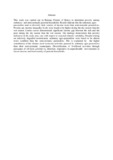| dc.contributor.author | Nyariki, Dickson M. | |
| dc.contributor.author | Elhadi, Y. A.M. | |
| dc.contributor.author | Wasonga, O V. | |
| dc.contributor.author | Ekaya, W. | |
| dc.date.accessioned | 2017-02-28T10:13:18Z | |
| dc.date.available | 2017-02-28T10:13:18Z | |
| dc.date.issued | 2012 | |
| dc.identifier.uri | http://hdl.handle.net/123456789/308 | |
| dc.identifier.uri | https://www.researchgate.net/publication/271832234_TRANSIENT_POVERTY_AMONG_PASTORAL_HOUSEHOLDS_IN_THE_SEMI-ARID_LOWLAND_OF_BARINGO_DISTRICT_KENYA | |
| dc.description.abstract | This study was carried out in Baringo District of Kenya to determine poverty among sedentary and semi-nomadic pastoral households. Results indicate that the sedentary agro- pastoralists tend to diversify their sources of income more than semi-nomadic pastoralists. Poverty and income inequality levels were found to be higher during the dry season than the wet season. Lorenz curves demonstrated significant income gap between the rich and the poor during the dry season than the wet season. The findings demonstrate that poverty indicators in the study area vary with respect to seasonal climatic variability. Despite relying on relatively degraded environment, sedentary agro-pastoralists were found to be almost twice wealthier than the semi-nomadic pastoralists. This is explained by the higher contribution of the climate-proof economic activities pursued by sedentary agro-pastoralists than their semi-nomadic counterparts. Diversification of livelihood activities through pursuance of off-farm activities is, therefore, imperative in unpredictable environments to ensure income and food security of pastoral households. | en_US |
| dc.language.iso | en | en_US |
| dc.title | Trasient Poverty among pastoral households in the semi-arid lowland of Baringo district, Kenya | en_US |
| dc.type | Article | en_US |


